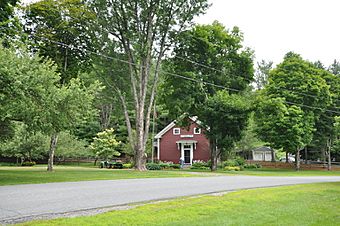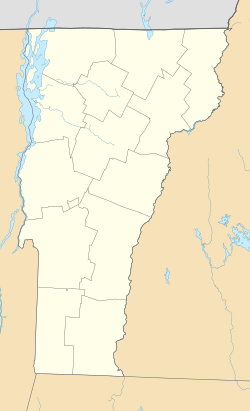Stockbridge Common Historic District facts for kids
Quick facts for kids |
|
|
Stockbridge Common Historic District
|
|

Part of the common, and the historic schoolhouse
|
|
| Location | Area around Stockbridge Common, including Maplewood Cemetery, Stockbridge, Vermont |
|---|---|
| Area | 15 acres (6.1 ha) |
| Built | 1804 |
| Architectural style | Greek Revival, Federal |
| NRHP reference No. | 90000800 |
| Added to NRHP | May 24, 1990 |
The Stockbridge Common Historic District is a special area in Stockbridge, Vermont. It includes the old town common, some historic buildings, and a cemetery. This district shows us what a small village looked like in the 1800s. It's a great example because it didn't change much over time.
This historic area was added to the National Register of Historic Places in 1990. The National Register is a list of places in the United States that are important to history. Being on this list helps protect these places for future generations.
Contents
What is the Stockbridge Common Historic District?
The Stockbridge Common Historic District covers about 15 acres. It is centered around the town common, which is like a public park or gathering space in the middle of the village. The common is surrounded by roads, and the Maplewood Cemetery is right next to it.
Buildings in the District
Around the common, you can find several old buildings from the 1800s. These buildings show different styles of architecture from that time.
- Keyes-Wright House: This house was started by Elias Keyes and finished around 1804 by Seth Wright. It's a large building built in the Federal style, which was popular in the early 1800s.
- Union Church: Built in 1826, this church is an example of the Greek Revival style. It was built on land that Elias Keyes also gave to the town.
- Old Schoolhouse: The former district schoolhouse was built in 1884. It's one of the newer buildings in the district, but it still shows how education happened in the past.
History of Stockbridge Common
The town of Stockbridge was officially started in 1761. However, people didn't begin settling there until the 1780s.
How the Village Began
A man named Elias Keyes was given land in Stockbridge. He agreed to build a saw mill and a grist mill. A saw mill cuts wood into lumber, and a grist mill grinds grain into flour. Keyes built these mills along the White River.
He also started building a house and set aside land for the town common and a cemetery. This area became the village of Stockbridge Common. Even though it had important buildings like a church and a school, the village didn't grow very big. It was a bit far from the river and main travel routes.
Changes Over Time
In the 1800s, another village called Gaysville grew much larger. Gaysville was right on the White River and had more industries. However, Gaysville's industries were badly damaged by the Great Vermont Flood of 1927. Because Stockbridge Common was not as developed, it was less affected by such big changes. This is why it remains a well-preserved example of a 19th-century rural village.



